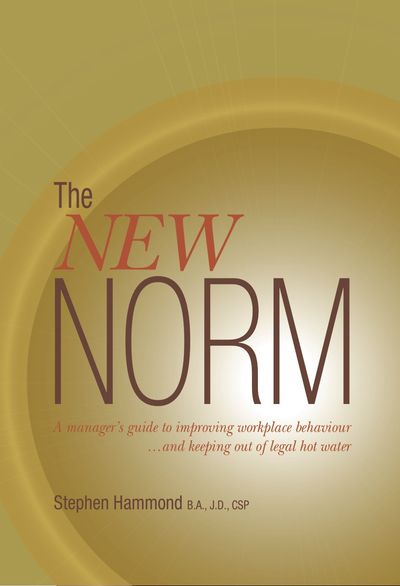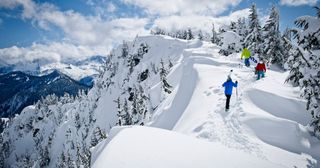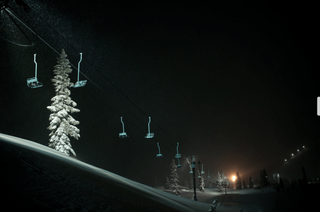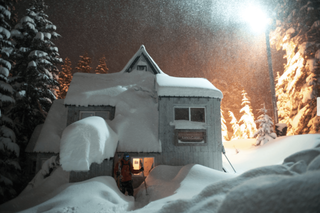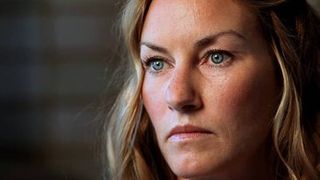Chapter twenty
THE NEW NORM has the nerve to speak up, even when part of a crowd
Cowboy Mountain is in the Cascade mountain range, about seventy-five miles east of Seattle. There, about 400,000 skiers and boarders visit the Stevens Pass ski resort each winter, the more adventurous experts hiking out of bounds to the other side, known as Tunnel Creek.
The lure of Tunnel Creek is the powder. On Sunday, February 19, 2012, sixteen expert skiers and boarders hiked about twenty minutes beyond the ski lifts to take in the incredible powder conditions found there. Among them: Megan Michelson, freestyle editor for the online sports site ESPN.com; Keith Carlsen, photographer and former editor of Powder magazine; Jim Jack, head judge of the Freeskiing World Tour; John Stifter, editor of Powder magazine; and Chris Rudolph, director of marketing for Stevens Pass Resort.
Some of these professionals were there for articles, photos and fun. They didn’t start out as sixteen people, but when word spread and the snow kept falling, their numbers got bigger…increasing the potential for the danger that a combination of a large crowd and huge snowfall poses.
On Saturday and overnight, thirty-two inches of fresh snow had fallen. That’s right, almost three feet. Anyone who knows powder drools over that kind of snow, but also recognizes its risk for triggering an avalanche.
The thirty-two inches formed a great block atop a hoar frost formed a couple of weeks earlier. Hoar frost is not completely compact, like other snow, so if enough weight is put on it, it can collapse and suddenly put the block of fresh, heavy snow on a rolling pin, ready to move. Most of the skiers involved knew the risk.
In a special eight-page section of the New York Times outlining the resulting disaster (also found online with incredible images, pictures and moving accounts), a number of survivors spoke of how a reluctance to speak up stood in the way of their own powder-smarts and common sense.
Keith Carlson said his feeling was that “there’s no way this entire group can make a decision that isn’t smart. Of course it’s fine, if we’re all going. It’s got to be fine.”
Megan Michelson added, “If it was up to me, I would never have gone backcountry skiing with twelve people.” (There were actually sixteen.) “But there were…social dynamics [to] that…I didn’t want to be the one to say, you know, ‘Hey, this is too big a group and we shouldn’t be doing this.’ I was invited by someone else, so I didn’t want to stand up and cause a fuss. And not to play the gender card, but there were two girls and ten guys, and I didn’t want to be the whiny female figure, you know? So I just followed along.”
Sensing there were too many people and realizing he had to get out of the dangerous part, Tim Wangen, a lifelong backcountry skier in the Stevens Pass area said, “I could see the others when I cut over. I thought: Oh yeah, that’s a bad place to be. That’s a bad place to be with that many people. But I didn’t say anything. I didn’t want to be the jerk.”
The skiers triggered an avalanche that buried four people: Elyse Saugstad, Jim Jack, Johnny Brenan and Chris Rudolph. Only Elysse Saugstad survived.
Saugstad, a professional skier, might have helped her survival by wearing an air bag in her backpack. Just before the avalanche hit her, she pulled a cord to release compressed air which inflated pillows behind her.
Yet, at the moment she used this relatively new and expensive equipment for exactly its purpose, the New York Times wrote that she “thought she would be embarrassed that she had deployed her air bag, that the other expert skiers she was with, more than a dozen of them, would have a good laugh at her panicked overreaction.”
It’s tragic how our inability to speak up – when we know we should –
can lead to such an ill-fated result.
The OLD NORM
- says nothing, even when she knows better, for fear she’ll be judged by others.
- allows peer pressure to get in the way of common sense even when there’s no real pressure – just the potential that someone might respond unfavourably.
- keeps quiet or goes along with others, not just in workplace situations, but on his own time when there’s no “boss.”
- allows silence to lead to unfortunate and even tragic results.
The NEW NORM
- feels peer pressure, but decides when it’s important enough to speak up.
- speaks up and knows that if she’s thinking it, she’s likely not alone.
- knows there may be times he stands alone, without the support of others, but he’s willing to go against the crowd when it’s important.
- knows that people with the best of intentions, with no ill-will, may keep quiet so she decides she will be the one to speak up.
Suggestions for the New Norm:
01
Speak up. This is the same message we learned in Chapter Eight with Dr. Bould the anesthesiologist. This is the same message whether it’s kids in school, adults at work or friends on a mountaintop. There are many strategies and policies in place to help people, but they are only as good as our ability to speak up in the first place. A trait of humans includes our desire to not rock the boat. Some people love rocking the boat and actually do it effectively and respectfully, but that’s rare for most people.
02
Fight the urge to keep important information to yourself. As many of the surviving skiers’ comments reflect, we often think something but don’t say it, even though there’s a really good chance one or more people are thinking the same thing. If you’re thinking it, say it. You may just hear a big sigh of relief from others in the room.
03
Reinforce Web-savviness at work. It’s very likely social media use will increase as it becomes even easier to access (right to our brains soon?). Therefore, it never hurts to educate and re-educate employees about social media’s potential harm.
This chapter lets you know
the tragedy of people not speaking up, even when they knew they should have. For examples of other problems related to people not speaking up, consider reading
Chapter 8: The New Norm speaks up regardless of hierarchy.
Purchase a copy of The New Norm, or if you think all your supervisors and managers, could learn many valuable lessons about creating a respectful workplace, free of harassment, bullying and discrimination, you can get volume discounts.
What one reader has to say about Stephen’s book, The New Norm
“Stephen’s book is a brilliant reminder of workplace situations that are disturbing, yet slip by unaddressed by so many in both the private and public sector. When these behaviours are unaddressed, they become the norm because we allow them to be.
Just like his first book, Stephen is insightful, his writing is moving and he inspires his readers to take immediate action to disapprove of, and address harassment and other inappropriate behaviour every time we see it, feel it and hear about it. In a concise format, he gives us a series of snapshots of old vs. new, acceptable vs. unacceptable, right vs. wrong, in a way that is understandable.
If workplace leaders take just some of Stephen’s practical advice, they will go a long way to rid their workplace of unacceptable behaviours such as harassment, discrimination and bullying. It’s clear that to create Stephen’s “New Norm,” we need to ACT NOW! We can’t wait any longer.”
Tatjana Zatezalo
Manager, Organizational Development, Halifax Regional Municipality

Respectful Workplace Online Training Course
If you, your employees or your managers want more information,
sign up for my new online training course:
The Respectful Workplace in Canada.
With 10 modules of useful, relevant and current information,
this course can help everyone at your workplace.
This may be the best online harassment training your people will get.
Stephen Hammond is a lawyer turned speaker and consultant in the field of harassment, sexual harassment, bullying and discrimination at work.
The New Norm is Stephen’s third book.
Here’s more information about Stephen.

